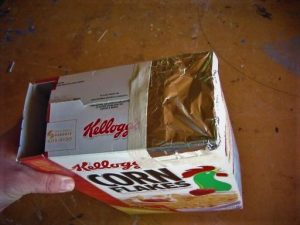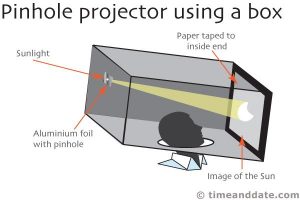Build a Cereal Box Eclipse Viewer
NASA activity adapted from Hila Science Camp in Ontario, Canada. It can be done in class or as an after-school, community, or family activity. Click here for classroom version, which includes learning standards and links to knowledge about eclipses.
Time: 20 minutes
Grade level: PreK-12
During a solar eclipse, it is very tempting to look directly at the sun as the moon moves across it, blocking out its light. But doing so is very dangerous and can result in permanent eye damage after just a few seconds.
You can protect your eyes and see the entire event by watching a projected image of the sun using a pin-hole projector.
Like the old-fashioned box cameras, pin-hole viewers have a tiny aperture, or opening, that acts much like a lens, creating an image on the back of the box much like the retina at the back of the eye.
A cereal box makes an excellent pinhole viewer, though any box will do.
Take breaks and look around you during the eclipse, advises the American Astronomical Society‘s guide to the experience. As the s un dwindles, shadows become sharper – to the point where you can see the hairs on your arm. The feeble light just before and after totality also creates beautiful, 360-degree sunset colors on the horizon.
un dwindles, shadows become sharper – to the point where you can see the hairs on your arm. The feeble light just before and after totality also creates beautiful, 360-degree sunset colors on the horizon.
Learning Standards
Next Generation Science Standards
- ESS1.B: Earth and the Solar System The solar system consists of the sun and a collection of objects, including planets, their moons, and asteroids that are held in orbit around the sun by its gravitational pull on them.
- MS-ESS1-3 This model of the solar system can explain eclipses of the sun and the moon. Earth’s spin axis is fixed in direction over the short-term but tilted relative to its orbit around the sun.
Materials 
- Empty cereal box – one per student
- White or colored paper
- Aluminum foil
- Tape
- Scissors
- Pin, thumb tack, or toothpick to poke hole
Procedure
- Viewing screen. Trace the bottom of the cereal box on a piece of white paper, cut out the shape, and tape it inside the bottom of box and seal the top.
- Viewer. Cut rectangular holes (about 1 inch from each edge, according to this short how-to video by University of Central Florida astronomy students) on the left and right side of the cereal box top.
- Lens. Cut a piece of aluminum foil to cover the left hole. Tape the foil in place.
- Poke a pinhole in the center of the foil.
- With the sun BEHIND you, look into the right hole.
- Watch a projection of the eclipse on the paper at the bottom of your viewer!
Extra credit: Cover the outside of the box with paper and decorate.
Note: Cereal boxes project a small, 3 mm image, but are easier for younger children to handle. A large box or long packing tube will project a bigger image.
Other DIY methods for building sun viewers:
- Skip the box! NASA’s Jet Propulsion Lab shows how to make a pinhole projector from a piece of paper and foil.
- This video from the San Francisco Exploratorium shows how to use binoculars on a tripod to focus an image of the sun on a large white cardboard screen for safe viewing. Another video shows Exploratorium physicist Paul Doherty making a similar sun viewer using a tripod-mounted monocular (spyglass) and cardboard.
- Chips-o-Scope. Using the same principles as the cereal box pinhole viewer, this AReResearch video shows how to transform a Pringles potato chip container into an eclipse viewer that several people can watch at the same time.

- No tools to tackle a Pringles package? The University of Illinois shows how to turn a cardboard tube into a pinhole viewer.
- Walmart’s summer eclipse lesson has instructions for both cereal box and potato chip tube viewers.
- 3D print a pinhole projector or make a 2-D model with your state and totality path using downloadable files from NASA.
- Room cameras and other ideas from pinholephotography.org.
- Not in the path of totality or unable to experience the eclipse? NASA’s main TV channel plans livestream “Eclipse Across America” broadcasts from 12 different locations on the ground, jets in the sky, telescopes, and dozens of high-altitude balloons. Feeds are scheduled to run from noon to 4 p.m. EDT.
- NASA’s Jet Propulsion Lab also offers an online web-based simulation.
Beware of unsafe eclipse-viewing “glasses” – especially DIY models that use exposed film. Check out the American Astronomical Society’s guide for how to tell if your eclipse glasses or handheld viewers are safe.
Filed under: Class Activities, Grades 6-8, Grades 9-12, Grades K-5, K-12 Outreach Programs, Special Features, Web Resources
Tags: Astronomy, camera obscura, cereal box, Class Activities, eclipse, informal science education, Lesson Plans, NASA, pinhole projector, STEM education, sun, viewer, Web Resources








